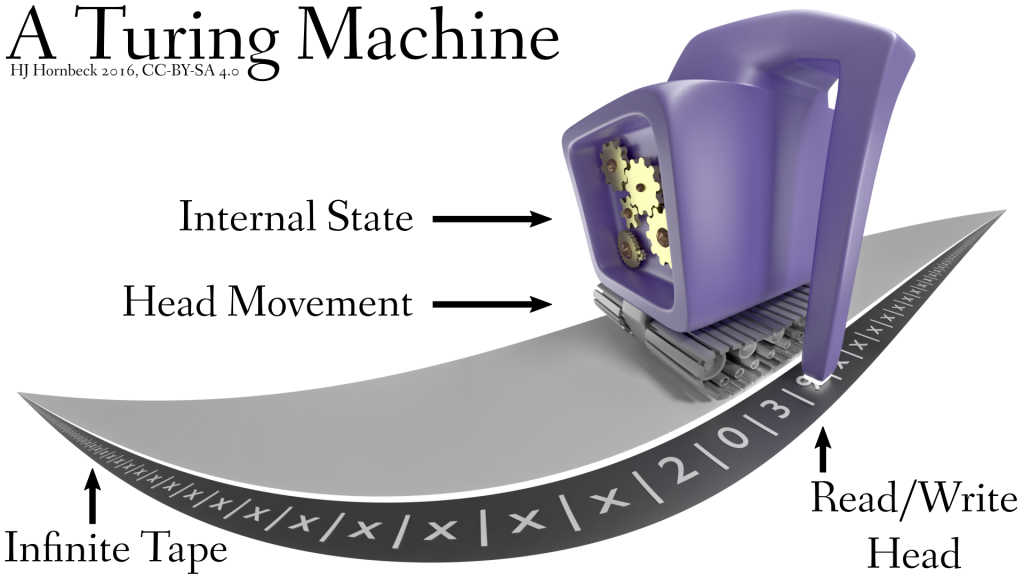At least he doesn’t start out that way.
The Second Law of Thermodynamics states that in an isolated system (one that is not taking in energy), entropy never decreases. … Closed systems inexorably become less structured, less organized, less able to accomplish interesting and useful outcomes, until they slide into an equilibrium of gray, tepid, homogeneous monotony and stay there.
For a non-physicist, it’s a decent formulation. It needs more of a description of entropy, though. In computer science, we think of it as how much information is or could be packed into an space. If I have a typical six-sided die, I can send you a message by giving it to you in a specific configuration. If I just ask you to look at a specific side, there are only six unique states to send a message with; if I also ask you to look at the orientation of the other sides, I can bump that up to twenty-four. I can’t send any more information unless I increase the number of states, or get to send multiple die or the same die multiple times. Compression is just transforming a low-entropy encoding into a high-entropy one, saving some time or space.
The physics version is closely related: how many ways can I shuffle the microscopic details of a system while preserving the macroscopic ones? If you’re looking at something small like a computer circuit, the answer is “not many.” The finely-ordered detail can’t be tweaked very much, and still result in a functional circuit. In contrast, the air above the circuit can be mixed up quite a bit and yet still look and act the same. Should a microscopic fluctuation happen, it’ll be far more harmful to the circuit than the air, so when they do inevitably happen the result is a gradual breaking up of the circuit. Its molecules will be slowly stripped off and brought into equilibrium with the air surrounding it, which also changes but less so.
Still with me? Good, because Pinker starts to drift off..
The Second Law of Thermodynamics is acknowledged in everyday life, in sayings such as “Ashes to ashes,” “Things fall apart,” “Rust never sleeps,” “Shit happens,” You can’t unscramble an egg,” “What can go wrong will go wrong,” and (from the Texas lawmaker Sam Rayburn), “Any jackass can kick down a barn, but it takes a carpenter to build one.”
That’s not really the Second Law, though. Pinker himself acknowledges that it only applies to closed systems, but anyone who’s looked up can attest that it isn’t. This comes up all the time in Creationist circles:
There is a mathematical correlation between entropy increase and an increase in disorder. The overall entropy of an isolated system can never decrease. However, the entropy of some parts of the system can spontaneously decrease at the expense of an even greater increase of other parts of the system. When heat flows spontaneously from a hot part of a system to a colder part of the system, the entropy of the hot area spontaneously decreases!
It’s bad enough that Pinker invokes a creationist-level understanding of physics, but he actually manages to make them look intelligent with:
To start with, the Second Law implies that misfortune may be no one’s fault. … Not only does the universe not care about our desires, but in the natural course of events it will appear to thwart them, because there are so many more ways for things to go wrong than to go right. Houses burn down, ships sink, battles are lost for the want of a horseshoe nail.
There is no “wrong” ordering of molecules in the air or a computer chip, only orderings that aren’t what human beings want. “Misfortune” is a human construct superimposed on the universe, to model the goal we strive for. It has no place in a physics classroom, and is completely unrelated to thermodynamics.
Poverty, too, needs no explanation. In a world governed by entropy and evolution, it is the default state of humankind. Matter does not just arrange itself into shelter or clothing, and living things do everything they can not to become our food. What needs to be explained is wealth. Yet most discussions of poverty consist of arguments about whom to blame for it.
Poverty is the inability to fulfill our basic needs. Is Pinker saying that, by default, human beings are incapable of meeting their basic needs, like food and shelter? Then he is effectively arguing we should have gone extinct and been replaced by a species which has no problems meeting its basic needs, like spiders or bacteria or ants. This of course ignores that economies are not closed systems, as the Sun helpfully dumps energy on us. Innovation increases efficiency and therefore entropy, which means that people who can’t gather their needs efficiently given what they have are living in a low entropic state.
But I thought entropy only increased over time, according to the Second Law? By Pinker’s own logic, poverty should not be the default but the past, a state that we evolved out of!
More generally, an underappreciation of the Second Law lures people into seeing every unsolved social problem as a sign that their country is being driven off a cliff.
Ooooh, I get it. This essay is just an excuse for Pinker to whine about progressives who want to improve other people’s lives. He thought he could hide his complaints behind science, to make them look more digestible to himself and others, but in reality just demonstrated he understands physics worse than most creationists.
What a crank. And sadly, that seems to be the norm in Evolutionary Psychology.
Tooby, John, Leda Cosmides, and H. Clark Barrett. “The second law of thermodynamics is the first law of psychology: evolutionary developmental psychology and the theory of tandem, coordinated inheritances: comment on Lickliter and Honeycutt (2003).” (2003): 858.


